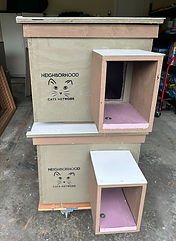
Resources
With some elementary skills and a few tools you can build one of our custom designed signature cat cabins.
For more information, click on the PDF below.

LEARN HOW TO BUILD AN EMERGENCY CAT CABIN
Learn how easy and affordable it is to make an emergency cat cabin to keep community cats near you safe and warm in the bitter cold months ahead.

NCN BUILDING PLAN FOR
CAT CABINS
Information for caring humans.
Frequently Asked Questions About Feral and Community Cats
WHAT IS A FERAL CAT?
A feral cat is a cat that has either been born in the wild or has reverted to a wild state after abandonment. Feral cats are generally not socialized to humans and tend to live in colonies.
WHAT IS A COMMUNITY CAT?
Community cats are free-roaming cats that may be feral or stray. These cats typically live in a specific area and are often cared for by one or more community members who provide food, water, and sometimes shelter.
HOW CAN YOU TELL IF A CAT IS FERAL OR STRAY?
Feral cats are usually wary of humans and avoid contact, while stray cats might approach humans or homes seeking food or shelter. Stray cats are often more socialized to people compared to feral cats.
WHAT IS TRAP-NEUTER-RETURN (TNVR)?
Trap-Neuter-Vaccinate-Return (TNVR) is a humane method of managing and reducing feral cat populations. Cats are trapped, spayed or neutered, vaccinated, and then returned to their original location. This helps prevent overpopulation and improves the health of the cats.
WHY IS TNVR IMPORTANT?
TNVR helps control the population of feral cats, reduces nuisance behaviors such as spraying and fighting, and improves the overall health and quality of life for the cats. It is also a more humane and effective method compared to euthanasia.
CAN FERAL CATS BECOME PETS?
While young feral kittens can sometimes be socialized and adopted as pets, adult feral cats are typically not suitable for life as indoor pets due to their lack of socialization to humans. They are usually better off remaining in their outdoor colonies.
HOW CAN I HELP FERAL CATS?
You can help by supporting local TNVR programs, providing food and water, and creating safe outdoor shelters. Additionally, spreading awareness about the importance of spaying and neutering can help reduce the feral cat population.
IS IT SAFE TO FEED FERAL CATS?
Yes, it is generally safe to feed feral cats. Providing food helps ensure they are healthy and can also make them easier to trap for TNVR programs. However, it's important to also work on long-term solutions like TNVR to manage the population.
WHAT SHOULD I DO IF I FIND A LITTER OF FERAL KITTENS?
If you find a litter of feral kittens, observe from a distance to see if the mother returns. If the kittens are in immediate danger, you may need to intervene. Otherwise, it's often best to leave them until they are weaned, then trap them for spaying/neutering and potential socialization if they are young enough.
WHAT IS EAR-TIPPING AND WHY IS IT DONE?
Ear-tipping is a practice where a small portion of a feral cat's ear is surgically removed during spaying or neutering. This is a universal sign that the cat has been sterilized and vaccinated, helping caregivers and animal control officers identify treated cats.
HOW CAN I BUILD A SHELTER FOR FERAL CATS?
You can build a simple and effective shelter using materials like plastic storage bins, Styrofoam coolers, or wooden crates. The shelter should be insulated, waterproof, and large enough for the cat to move around but small enough to retain body heat. Place it in a safe, quiet location away from traffic and predators. See the video on our website on how to make an emergency shelter.
CAN FERAL CATS BE RELOCATED?
Relocating feral cats is generally not recommended as they are very territorial and may not survive in a new environment. Relocation should only be considered as a last resort, and it must be done following specific protocols to ensure the cats’ safety and adaptation to the new location.
WHAT ARE THE BENEFITS OF HAVING FERAL CATS?
Community cats can help control rodent populations and reduce the number of unsterilized cats in the area through TNR programs. They can also provide companionship to community members and bring attention to the importance of responsible pet ownership and wildlife conservation.
HOW DO I SAFELY TRAP A FERAL CAT FOR TNVR?
To safely trap a feral cat, use a humane trap that is properly sized for cats. Bait the trap with food, such as tuna or sardines, and place it in an area where the cat frequently visits. Monitor the trap regularly and cover it with a blanket or towel once the cat is trapped to help keep it calm. Transport the cat to a veterinary clinic for spaying/neutering and vaccination.
WHAT IS THE IMPACT ON SPAYING/NEUTERING ON FERAL CAT BEHAVIOR?
Spaying/neutering can significantly impact feral cat behavior by reducing mating-related activities such as roaming, fighting, and yowling. It can also decrease the risk of certain health issues, contribute to a more stable and healthier colony, and prevent the birth of more feral kittens.
HOW CAN I HELP EDUCATE MY COMMUNITY ABOUT FERAL CATS AND TNR?
You can educate your community by organizing informational sessions, distributing pamphlets, using social media platforms, and collaborating with local animal shelters or TNR organizations. Highlighting the benefits of TNR and the importance of humane treatment of feral cats can foster community support.
WHAT SHOULD I DO IF A NEIGHBOR IS FEEDING FERAL CATSBUT NOT PARTICIPATING IN TNVR?
Approach your neighbor with information about TNVR and its benefits for the cats and the community. Offer to assist in the process or connect them with local TNVR groups. Educating them on the long-term benefits of spaying/neutering can encourage participation in TNR efforts.
WHAT ARE COMMON MYTHS ABOUT FERAL CATS?
Common myths include the belief that feral cats cannot be healthy, that they can easily be adopted as pets, and that they significantly threaten wildlife. In reality, managed feral cats can be healthy, adult feral cats are generally not suited for adoption, and TNVR programs help mitigate their impact on wildlife.
ARE THERE SPECIAL CONSIDERATIONS FOR FERAL CATS DURING EXTREME WEATHER?
Yes, during extreme weather, it’s crucial to provide adequate shelter, such as insulated shelters in winter and shaded areas in summer. Ensure a consistent supply of fresh water, and in freezing conditions, use heated water bowls if possible. Monitoring the cats' health more frequently during extreme weather is also important.
WHO CAN I CONTACT IF I HAVE QUESTIONS?
You can contact us at: info@neighborhoodcatsnetwork.org
Helpful Information
Click on the titles to learn more about feral cats.
Articles
-
Why Trap-Neuter-Return Feral Cats? The Case for TNR (Alley Cats Allies)
Videos
